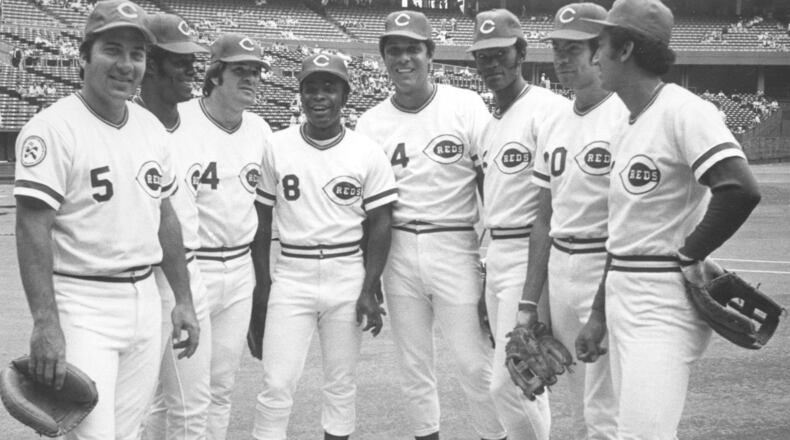A: I neither endorse political candidates nor commercial products. And I don’t endorse booing, although I realize it has been around since the Christians versus the Lions. Fans pay enough money for a week’s groceries to take their family to a game. So as long as they don’t throw a can or a bottle out of a grocery bag, booing is OK. If a player accepts cheers, he best be ready to accept boos.
Q: In your opinion, what member of the Big Red Machine was the key to Cincinnati’s success in the 1970s? — SCOTT, Jamestown, NY.
A: Of all the questions I’ve received all these years, this one is, without a doubt, the toughest I’ve ever received. And you know what? Even though I covered them and traveled with them, I don’t know know the answer. There wasn’t just one key, the BRM was a ring of keys. Pete Rose. Johnny Bench. Tony Perez. George Foster. Joe Morgan. Dave Concepcion. Ken Griffey Sr. They just can’t be separated and, to me,; it is impossible to point at one and say, “He was the key to the Big Red Machine.” Sorry, I just can’t.
Q: Should there be a time clock on the coach when he comes from the dugout to talk to his pitcher? — GREG, Beavercreek.
A: Great idea. Most pitching coaches walk to the mound as if they are on their way to talk to the IRS. They can be timed with the sands through an hour glass. And most of the time they are just stalling for time so a relief pitcher can get ready. My solution would be, “No visits.” If a coach comes out, the pitcher comes out, too. No more social visits on the mound.
Q: How long can a player take on paternity leave and does he get paid? — KOZ, Springfield.
A: As of 2011, when it became part of baseball’s bargaining agreement, a player may take three days off when his wife gives birth. And, yes, they get paid. The team can replace him with any player on its 40-man roster. It hasn’t always been accepted by fringe observeres. One Boston radio guy said, “These guys work six months out of the year and they can take days off to stay home and tickle the baby.” Now there’s a guy who needs time off for sensitivity training.
Q: Before the Cincinnati. Reds bent over backwards to sign Greg Vaughn in 1999, they were to be clean-shaven and have a respectable hair style. Wouldn’t it be nice to get that rule reinstated? — MATT, Springfield.
A: Your definition of ‘respectable’ and the definition of the younger generation differ. Hair styles come and go and what has returned is major league pitchers looking like Civil War generals. Beards, mustaches and long stringy hair have nothing to do with hits and runs or balls and strikes. It is what’s under the hair that counts. If a pitcher can throw a complete-game shutout, I don’t care if he looks like a member of ZZ Top.
Q: Why do they only use two umpires in Class A baseball? — CONLEY, Warsaw, IN.
A: Because two guys missing calls is better than four guys missing calls? They will tell you it’s economics, yet they pay Class A umpires $2,000 a month while they use four umpires in MLB who are paid from $125,000 to $300,000 a year. Two umpires are traditional from Little League to high school, but they even use four umpires in Division I college baseball. It is also said that by using one umpire in Class A on the bases, that umpire learns more. He has to pay rapt attention and cover all the different angles. But when it comes to checked swings, he has no clue. But sometimes MLB umpires have no clue on that call, either.
Q: Reds manager David Bell often uses both his catchers in a game, so who is the team’s emergency catcher? — STEVE, Owensboro, KY.
A: Fortunately for Bell and the Reds, that dilemma hasn’t yet surfaced. But the way the Reds get hurt more often than a sparrow flying into a close window, it is bound to happen. It probably is Spencer Steer, who can play every position. And it could be Stuart “Spiderman” Fairchild, who would be amazing climbing the backstop screen to snag foul pop-ups.
Q: Are the Reds on track to set a record for most batters hitting under .200? — DENNIS, Centerville.
A: While the Reds regularly have three or four ‘hitters’ in the lineup hitting below .200, so do many other teams this season. In recent series, the St. Louis Cardinals, New York Yankees and the Detroit Tigers had that dubious distinction. Batting .250 nowadays is the new .300. The MLB average is around .240. What is amazing is that the 1962 New York Mets lost 120 games and didn’t have a batter in Casey Stengel’s regular lineup hitting below .236 and that was Elio Chacon. All the rest hit above .241.
Q: Ted Klusewski cut the sleeves off his uniform because they restricted his swing due to his bulging biceps, so what latitude do players have in altering their uniforms? — JERRY, Springfield.
A: Do the clothes make the man or does the man make the clothes? After Klu did that, the Reds began wearing sleevless uniforms to accommodate Big Klu. Uniforms mean just that ... they have to be uniform. Everybody the same. But I wish they would put in a pants clause. Some players wear their pants above the knees and some wear them over their shoes dragging the dirt.
About the Author
